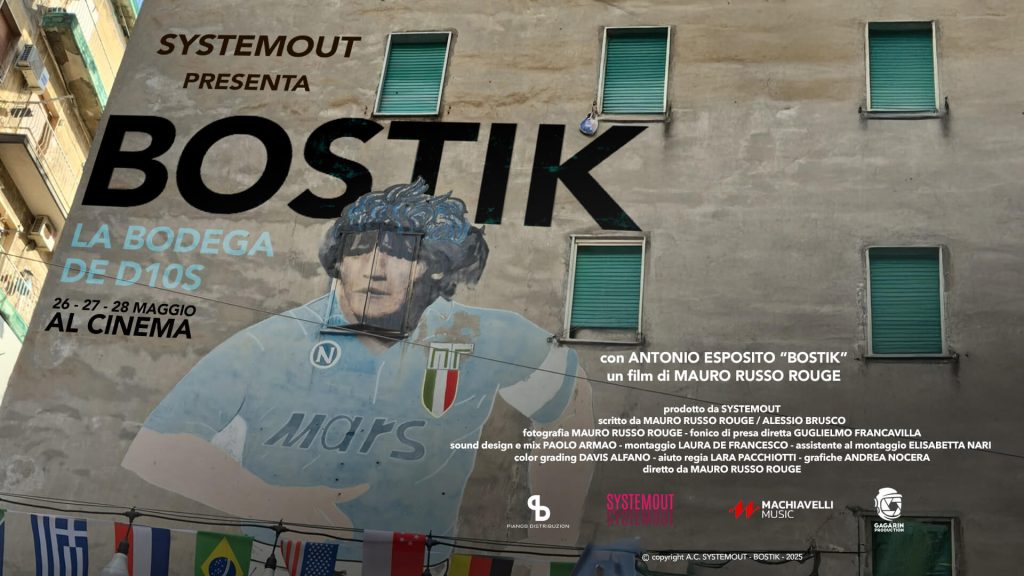BOSTIK LA BODEGA DE D10S, a film by Mauro Russo Rouge
with Antonio Esposito, “Bostik”
SYNOPSIS
Antonio Esposito, known as “Bostik” in the Spanish Quarters of Naples, is considered a true local legend. For many, the “real tomb of Maradona” is located there thanks to him. It all began in the 1990s when Antonio commissioned a mural in honor of the Argentine champion. Today, that square has become a tourist destination for football fans from all over the world. Antonio created a commemorative shrine with jerseys, photos, memorabilia, and a plaster bust, transforming a place once marked by drug dealing into a landmark for football enthusiasts. His “Largo Maradona” has become a true football shrine, thanks to his dedication. Founder of the “Teste Matte”, an ultras group supporting Napoli, Antonio contributed to the revitalization of the neighborhood, a symbol of redemption and renewal, fueled by his devotion to Maradona.
DIRECTOR’S STATEMENT
I met Antonio Bostik a few years ago. It was 2020, in the midst of the Covid emergency. He traveled between Naples and Turin several times a year to visit one of his daughters, and there were always opportunities to meet up and have dinner together. Strangely enough, during those evenings, we never talked about football, let alone Maradona. We discussed everything, except for that almost sacred veneration Antonio had for “El Pibe de Oro.” For me, at that time, football was the last thing on my mind. I was immersed in two completely different projects, and even if he had talked to me about football, I probably wouldn’t have really picked up on it. My mind was elsewhere.
Then, in mid-2023, during one of our many dinners, his daughter started insisting that I should make a documentary about her father. At first, I didn’t understand why she was so persistent. I couldn’t see what was so special about him, what story was worth telling. But my curiosity began to grow, and I started doing some research.
After a few weeks, I had already made my decision: two trips to Naples to film what brings Largo Maradona, the mural, and the Spanish Quarters to life—a place steeped in history, culture, and an undying love for Diego. I felt that behind that icon, there was something deeper to explore, something intertwined with the soul of the city itself.
Making a documentary is very different from fiction cinema. It’s an unpredictable journey that takes shape in a spontaneous way, especially when you encounter characters like Antonio. Organizing and scheduling with him was anything but easy. He’s always incredibly busy, and he doesn’t like following instructions. But there was empathy between us, a mutual respect that, despite everything, allowed me to enter his life. I had to make it clear right away: I would become his shadow, following him closely. This made him uncomfortable at first, it was obvious.
But after getting over his initial reluctance, he came around. After twelve exhausting days of filming, Antonio was worn out. He couldn’t wait for us to leave Naples. That much was clear.
One of the biggest challenges was getting him to leave the Spanish Quarters. That is his territory, his refuge, and convincing him to move outside of it was like pulling him out of his comfort zone—a small battle, really. But in the end, we managed, even though it wasn’t easy.
I spent almost two weeks following him around, in May 2024. The heat was already unbearable, and filming in the Spanish Quarters with all the equipment was far from easy. When you walk through those narrow alleys with cameras and microphones, you can’t go unnoticed. Everyone stops, watches you, some approach, and many want to be filmed. That’s how Naples is: the people are the heart of the city, and the desire to appear, to tell their story, is strong.
Watching the documentary, the audience will have an immersive experience. It will not just be a journey through the cult of Maradona, but an immersion into the authentic Naples—the narrow streets, the voices echoing off the colorful facades, the raw and genuine emotions. People won’t just see the mural as a piece of art, they will feel its soul. They will feel the palpable devotion of the neighborhoods, where Maradona is not just a football champion but a living legend, almost a secular saint.
Through Antonio’s eyes, the viewer will better understand how a man, with all his talent and contradictions, became a symbol of redemption for an entire people. They will feel the pride and pain of a city that clings to that image of Maradona as a hope, an identity that defies time.
The documentary will allow those watching to immerse themselves in a sensory experience. They’ll hear the sounds of the Spanish Quarters—the motorbikes speeding by, the children playing football, the laughter and singing of the people. The viewer will get lost in those narrow streets as if they were there, surrounded by the warmth of the people and the intensity of their passion. And then, the mural. That gaze of Maradona, following you wherever you go, which for Neapolitans is not just an icon but almost a protective presence. Anyone who watches this documentary will feel that connection between man, myth, and city—a connection that goes beyond football, touching the very soul of Naples.
DATA SHEET
Title: BOSTIK, LA BODEGA DE D10S
Year of production: 2025
Duration: 82′
Type: Documentary
Country: Italy
Screening format: DCP, color
Direction: Mauro Russo Rouge
Production: AC SystemOut
With: Antonio Esposto “Bostik”
Cinematography: Mauro Russo Rouge
Sound design and Mix: Paolo Armao
Editing: Laura De Francesco
Boom operator: Guglielmo Francavilla
Press release from Echo Group.

